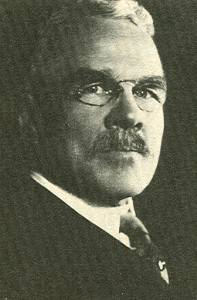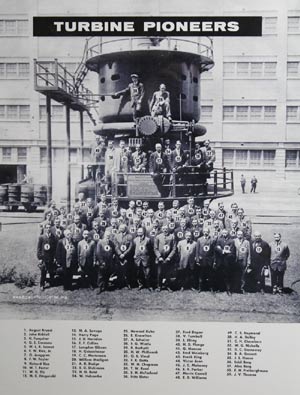Charles G. Curtis
Pioneer in steam and gas turbines
 |
Charles Gordon Curtis (1860-1953) was born April 20, 1860 in Boston, Massachusetts. He graduated from Columbia University with a civil engineering degree in 1881. He also studied law at the New York Law School and graduated in 1883. For several years, Curtis was a patent lawyer, but decided to give up his practice in 1891 to organize the C & C Electrical Motor Company to manufacture electric motors and fans. |

|
Above: a GE gas turbine. Over 100 years after Curtis's work on gas turbines GE is still a dominent player in the gas turbine market. Right: one of Curtis's great innovations, the vertical steam turbine. Many other help develop this as seen in the photo but it was Curtis and William Emmet who were the masterminds. He then studied the “scavenging” (removal of burned gases from cylinders) of two-stroke diesel engines and patented the Curtis system of scavenging in 1930. Historians also credit Curtis with inventing the propulsion mechanism used in certain naval torpedoes. He received the first annual award from the Gas Turbine Power Division of the American Society of Mechanical Engineers (ASME) in 1948. In 1950 he received the Holley Medal from ASME, also for his gas turbine work. Charles Curtis died in Central Islip, New York, on March 10, 1953. |
|
Watch our video on the history of Steam Turbines where Historian George Wise talks about the early days of steam turbines, Parsons, Curtis, Emmet and more.
Photos:
Edison Tech Center
General Electric
Sources:
Edwin Reilly Jr.
The General Electric Story. by Bernard Gorowitz. 1999
If you are a historian and wish to correct facts or publish a commentary or embedded article feel free to contact us.
Image Use:
Photos:: Permission and fees are required for use of photos in printed or internet publications.
Educational Use:: Students and teachers may use photos and videos at school. Graphics and photos must retain the Edison Tech Center watermark or captions and remain unmanipulated except for sizing.
Videos:: DVDs are available for personal/educational use. Republication of any part or whole of any ETC video requires a professional license agreement. Contact us for legal permissions and fees.
Edison Tech Center
General Electric
Sources:
Edwin Reilly Jr.
The General Electric Story. by Bernard Gorowitz. 1999
If you are a historian and wish to correct facts or publish a commentary or embedded article feel free to contact us.
Photos:: Permission and fees are required for use of photos in printed or internet publications.
Educational Use:: Students and teachers may use photos and videos at school. Graphics and photos must retain the Edison Tech Center watermark or captions and remain unmanipulated except for sizing.
Videos:: DVDs are available for personal/educational use. Republication of any part or whole of any ETC video requires a professional license agreement. Contact us for legal permissions and fees.


